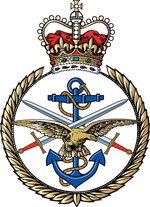British Armed Forces
|
|
| Military of the United Kingdom | |
 The tri-service badge: Royal Navy, British Army and Royal Air Force. | |
| Military manpower | |
| Availability (males age 15-49) | 14,943,016 (2004 est.) |
| Fit for military service (males age 15-49) | 12,393,785 (2004 est.) |
| Military expenditures | |
| Sterling figure (FY04/05) | £32.6 billion |
| Dollar figure (FY04/05) | $61.3 billion |
| Percent of GDP (2004) | 2.6% |
| Military strength | |
| British Army | |
| Main Battle Tanks | 386 Challenger 2 |
| Infantry fighting vehicles | 575 Warrior |
| Armoured Personnel Carriers | 4,000+ |
| Artillery | 400 |
| Aircraft | 290 |
| Personnel (Regular Army) | 112,700 |
| Personnel (Territorial Army) | 40,000+ |
| Royal Navy | |
| Ballistic Missile Submarines | 4 |
| Fleet Submarines | 11 |
| Aircraft Carriers | 3 |
| Helicopter Carrier | 1 |
| Destroyers | 11 |
| Frigates | 20 |
| Patrol boats | 26 |
| Amphibious Assault ships | 2 |
| Minesweepers | 22 |
| Survey vessels | 4 |
| Aircraft | 210 |
| Personnel (Regular) | 40,900 |
| Personnel (Royal Naval Reserve) | 3,250 |
| Personnel (Royal Marines Reserve) | 600 |
| Royal Fleet Auxiliary | |
| Tankers | 9 |
| Resupply ships | 2 |
| Tanker/Resupply ships | 2 |
| Aviation training ship | 1 |
| Repair ship | 1 |
| Amphibious Assault ships | 5 |
| Strategic lift vessels | 2 |
| Royal Air Force | |
| Aircraft | 942 (including helicopters) |
| Personnel | 53,400 |
The armed forces of the United Kingdom are known as the British Armed Forces or Her Majesty's Armed Forces, officially the Armed Forces of the Crown. Their Commander-in-Chief is the Queen and they are managed by the Ministry of Defence.
The British Armed Forces are charged with protecting the United Kingdom and its overseas territories, promoting Britain's wider security interests, and supporting international peacekeeping efforts. They are active and regular participants in NATO and other coalition operations.
The British Army had a reported strength of 112,700 in 2004, including 7,600 women, and the Royal Air Force a strength of 53,400. The 40,900-member Royal Navy is in charge of the United Kingdom's independent strategic nuclear arm, which consists of four Trident missile submarines, while the Royal Marines provide commando units for amphibious assault and for specialist reinforcement forces in and beyond the NATO area. This puts total active duty military troops in the 210,000 range.
Along with France and Russia, Britain fields one of the most powerful and comprehensive military forces in Europe. Despite Britain's wide ranging capabilities, recent defence policy has a stated assumption that any large operation would be undertaken as part of a coalition. Bosnia, Kosovo, Afghanistan, Iraq (Granby, No-Fly-Zones, Desert Fox and Telic) may all be taken as precedent - indeed the last true war in which the British military fought alone was the Falklands War of 1982.
| Contents |
Branches
- Royal Navy, including Royal Marines
- British Army
- Royal Air Force
Recent Defence Reviews
- Options for Change (1993)
- Strategic Defence Review (1998)
- Delivering Security in a Changing World [1] (http://www.mod.uk/issues/security/cm6269/index.html) (2003)
See also
- British military history
- Admiralty
- Military of the Falkland Islands
- National Service
- The United Kingdom and weapons of mass destruction
- List of United Kingdom topics
External Links
- kamouflage.net: online index of camouflage uniforms from around the world (http://www.kamouflage.net/)
- kamouflage.net > global search: Europe > United Kingdom > index (http://www.kamouflage.net/camouflage/00165/en_index.php)
| North Atlantic Treaty Organisation (NATO) | 
|
|---|---|
| Belgium | Bulgaria | Canada | Czech Republic | Denmark | Estonia | France | Germany | Greece | Hungary | Iceland | Italy | Latvia | Lithuania | Luxembourg | The Netherlands | Norway | Poland | Portugal | Romania | Slovakia | Slovenia | Spain | Turkey | United Kingdom | United States of America | |
